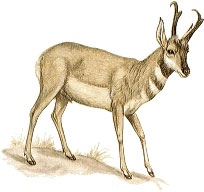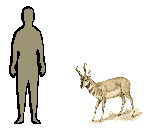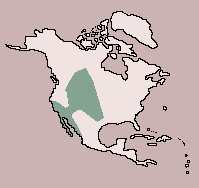Pronghorn

| Class: Mammalia:
Mammals |
Diet: Grass |
| Order:
Artiodactyla: Even-toed Ungulates |
| Size: body:
1 - 1.5 m (3 1/4 - 5 ft), tail: 7.5 - 10 cm (3 - 4 in) |
| Family: Antilocapridae:
Pronghorn |
Conservation Status: Non-threatened
|
| Scientific Name:
Antilocapra americana |
Habitat: open prairie,
desert |
| Range:
Central Canada, Western USA, Mexico |
 Both
male and female pronghorns have true, bony horns, although those of females
are small and inconspicuous. The horns are covered with sheaths of specialized,
fused hairs, and pronghorns are unique in that these sheaths are shed annually.
The small, forward-pointing branch on each horn, the prong, is in fact
part of this sheath. Both
male and female pronghorns have true, bony horns, although those of females
are small and inconspicuous. The horns are covered with sheaths of specialized,
fused hairs, and pronghorns are unique in that these sheaths are shed annually.
The small, forward-pointing branch on each horn, the prong, is in fact
part of this sheath.  One
of the fastest running mammals in North America, the pronghorn can achieve
speeds of up to 65 km/h (40 mph). It is also a good swimmer. In summer,
it moves in small, scattered groups but congregates in larger herds of
up to 100 animals in winter. Pronghorns are active during the day but feed
mostly in the morning and evening, taking grasses, weeds and shrubs such
as sagebrush. White hairs on the pronghorn's rump become erect if the animal
is alarmed and act as a warning signal to other pronghorns. Some males
collect harems, fighting rival males for the privilege. The female gives
birth to her young after a gestation of 230 to 240 days; there is usually
only 1 in a female's first litter, but in subsequent years, she produces
2, or even 3, young. Only 4 days after birth, pronghorns can outrun humans.
Pronghorns are now rare due to over-hunting, competition for food from
domestic livestock and the destruction of their natural habitat. One
of the fastest running mammals in North America, the pronghorn can achieve
speeds of up to 65 km/h (40 mph). It is also a good swimmer. In summer,
it moves in small, scattered groups but congregates in larger herds of
up to 100 animals in winter. Pronghorns are active during the day but feed
mostly in the morning and evening, taking grasses, weeds and shrubs such
as sagebrush. White hairs on the pronghorn's rump become erect if the animal
is alarmed and act as a warning signal to other pronghorns. Some males
collect harems, fighting rival males for the privilege. The female gives
birth to her young after a gestation of 230 to 240 days; there is usually
only 1 in a female's first litter, but in subsequent years, she produces
2, or even 3, young. Only 4 days after birth, pronghorns can outrun humans.
Pronghorns are now rare due to over-hunting, competition for food from
domestic livestock and the destruction of their natural habitat.
  
|

